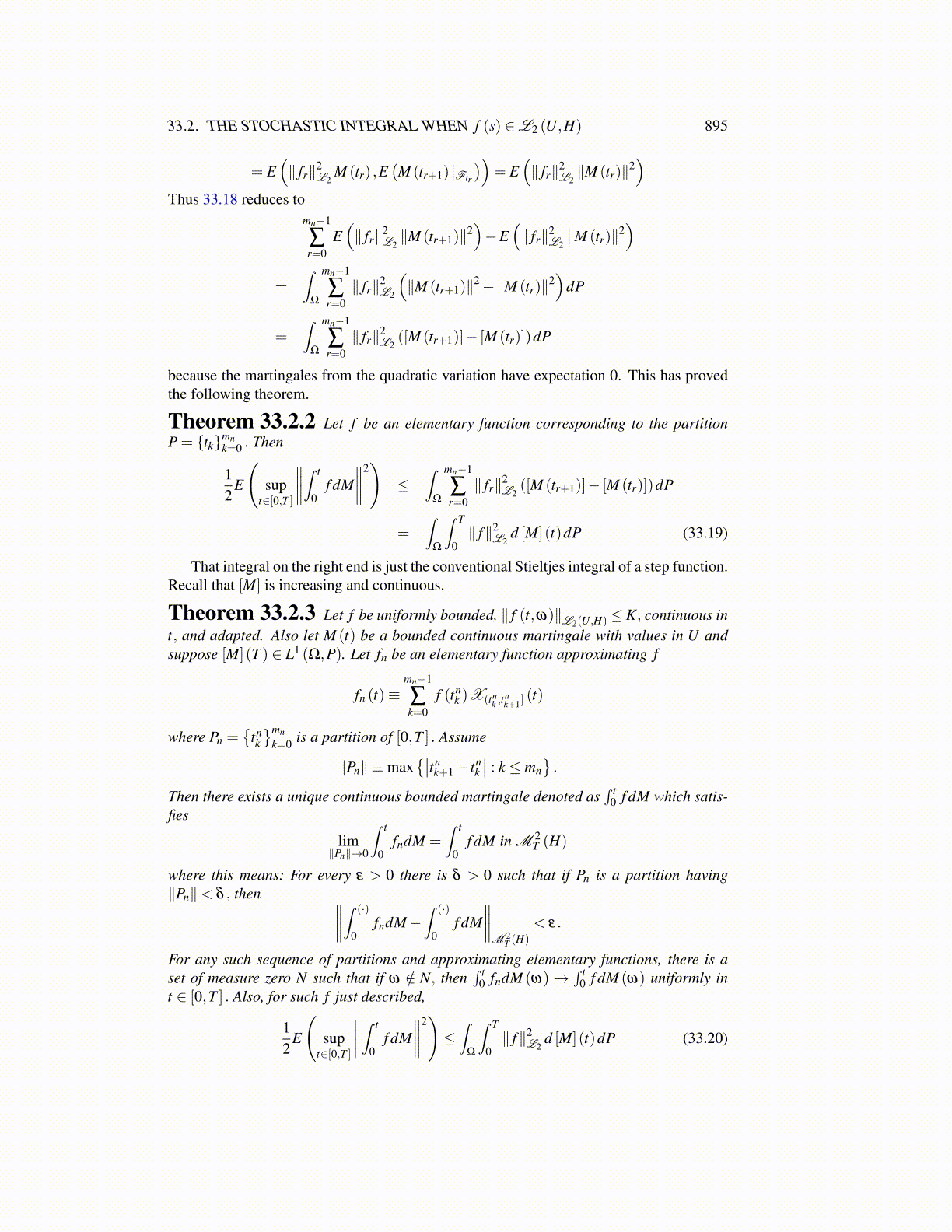
33.2. THE STOCHASTIC INTEGRAL WHEN f (s) ∈L2 (U,H) 895
= E(∥ fr∥2
L2M (tr) ,E
(M (tr+1) |Ftr
))= E
(∥ fr∥2
L2∥M (tr)∥2
)Thus 33.18 reduces to
mn−1
∑r=0
E(∥ fr∥2
L2∥M (tr+1)∥2
)−E
(∥ fr∥2
L2∥M (tr)∥2
)=
∫Ω
mn−1
∑r=0∥ fr∥2
L2
(∥M (tr+1)∥2−∥M (tr)∥2
)dP
=∫
Ω
mn−1
∑r=0∥ fr∥2
L2([M (tr+1)]− [M (tr)])dP
because the martingales from the quadratic variation have expectation 0. This has provedthe following theorem.
Theorem 33.2.2 Let f be an elementary function corresponding to the partitionP = {tk}mn
k=0 . Then
12
E
(sup
t∈[0,T ]
∥∥∥∥∫ t
0f dM
∥∥∥∥2)≤
∫Ω
mn−1
∑r=0∥ fr∥2
L2([M (tr+1)]− [M (tr)])dP
=∫
Ω
∫ T
0∥ f∥2
L2d [M] (t)dP (33.19)
That integral on the right end is just the conventional Stieltjes integral of a step function.Recall that [M] is increasing and continuous.
Theorem 33.2.3 Let f be uniformly bounded, ∥ f (t,ω)∥L2(U,H) ≤K, continuous int, and adapted. Also let M (t) be a bounded continuous martingale with values in U andsuppose [M] (T ) ∈ L1 (Ω,P). Let fn be an elementary function approximating f
fn (t)≡mn−1
∑k=0
f (tnk )X(tn
k ,tnk+1]
(t)
where Pn ={
tnk
}mnk=0 is a partition of [0,T ] . Assume
∥Pn∥ ≡max{∣∣tn
k+1− tnk
∣∣ : k ≤ mn}.
Then there exists a unique continuous bounded martingale denoted as∫ t
0 f dM which satis-fies
lim∥Pn∥→0
∫ t
0fndM =
∫ t
0f dM in M 2
T (H)
where this means: For every ε > 0 there is δ > 0 such that if Pn is a partition having∥Pn∥< δ , then ∥∥∥∥∫ (·)
0fndM−
∫ (·)
0f dM
∥∥∥∥M 2
T (H)
< ε.
For any such sequence of partitions and approximating elementary functions, there is aset of measure zero N such that if ω /∈ N, then
∫ t0 fndM (ω)→
∫ t0 f dM (ω) uniformly in
t ∈ [0,T ] . Also, for such f just described,
12
E
(sup
t∈[0,T ]
∥∥∥∥∫ t
0f dM
∥∥∥∥2)≤∫
Ω
∫ T
0∥ f∥2
L2d [M] (t)dP (33.20)